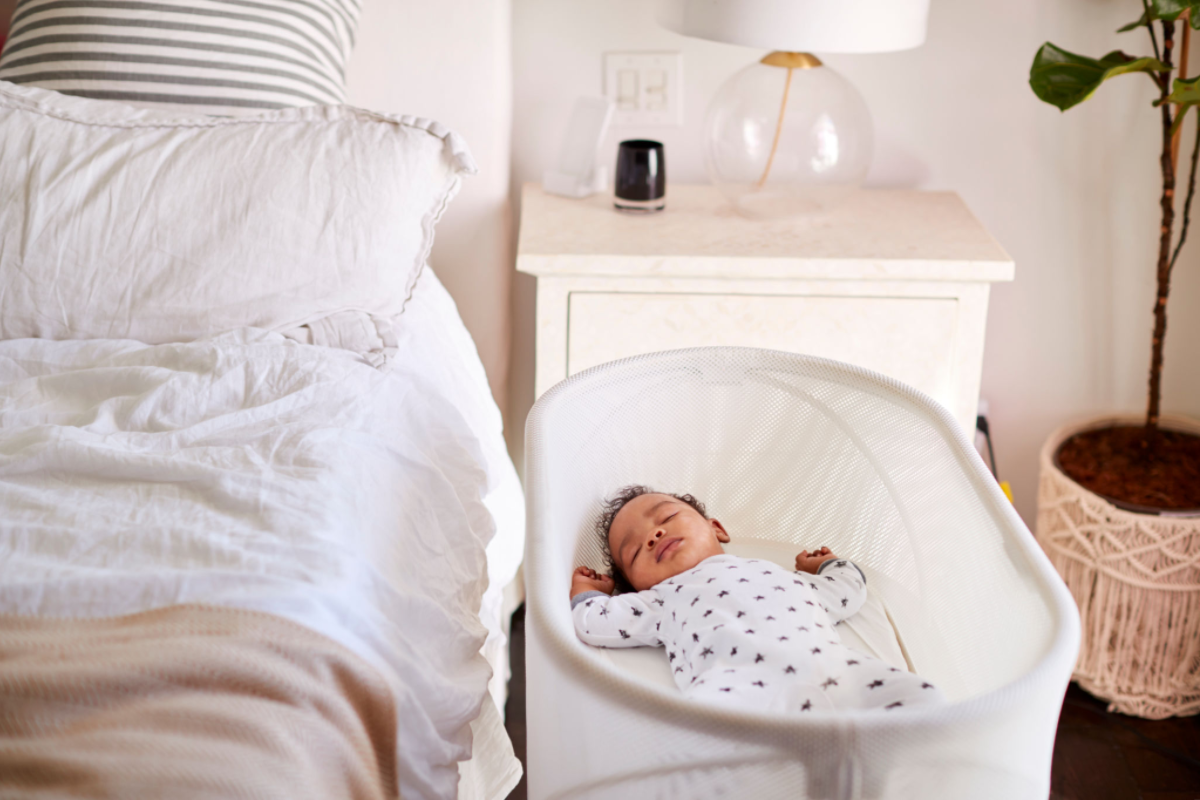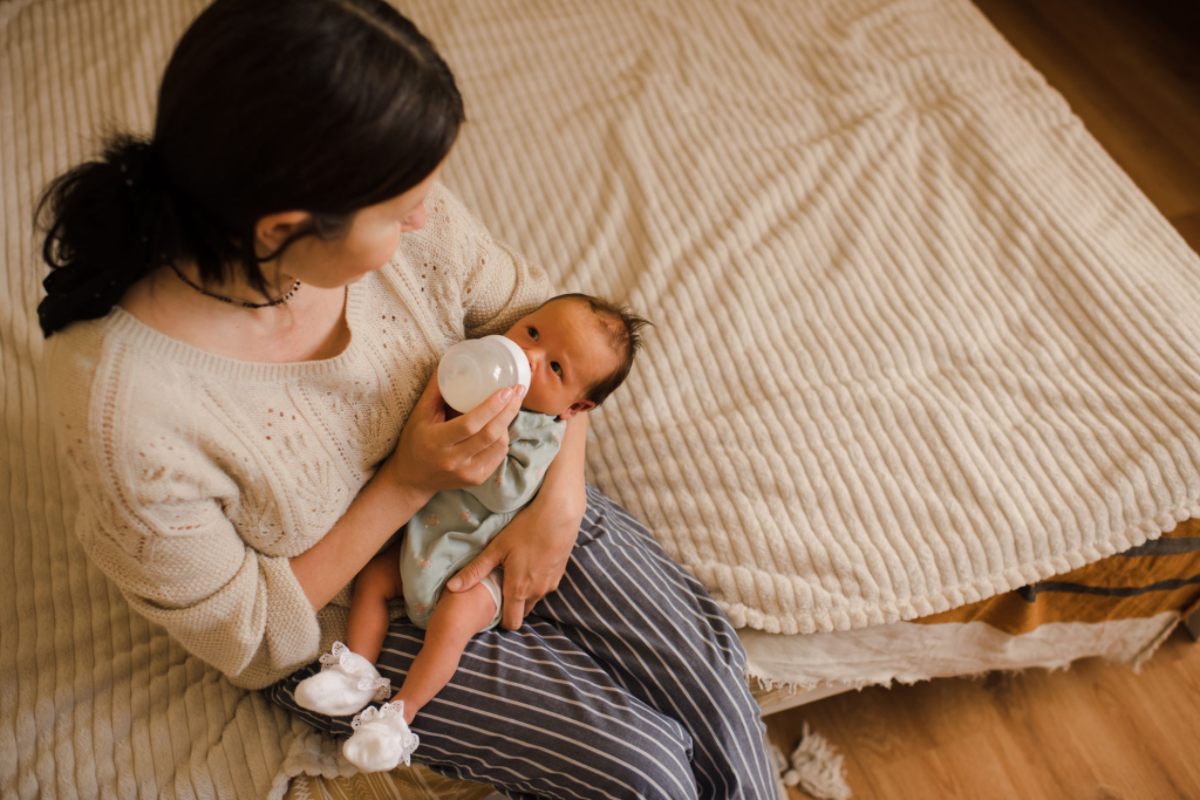At Motherhood Center in Houston, Texas, we understand the transformative power of a well-crafted bedtime routine for your baby. Our dedicated team of specialists has been helping families with infants, and expectant mothers for over two decades. We’ve witnessed firsthand the magic that unfolds when you establish a consistent bedtime ritual.
In this comprehensive guide, we’ve collaborated with experts to bring you a roadmap to creating a serene bedtime routine for your baby. From selecting the right bedtime to building a calming sleep environment, you’ll discover how to embrace the nurturing moments with your baby. We’ll explore the benefits of a soothing bath, the importance of gentle nighttime feedings, and the art of bonding during snuggle time.
Whether you’re looking for guidance on swaddling and sleepwear, mastering nap time, or addressing common sleep challenges, we’ve got you covered. By the end of this guide, you’ll have the tools to create a bedtime routine that not only promotes better sleep but also deepens the precious connection between you and your baby. Let’s embark on this journey together, hand in hand with the experts at Motherhood Center, to make bedtime a cherished and tranquil experience for both you and your little one.
Choosing the Right Time
One of the cornerstones of establishing a successful bedtime routine for your baby is choosing the right time for their bedtime. At the Motherhood Center, we recognize the importance of this decision, as it sets the foundation for a peaceful night’s sleep for both you and your baby. Here, we’ll guide you through determining the ideal bedtime and adjusting it as your baby grows.
Determining Your Baby’s Ideal Bedtime
Every baby is unique, and their ideal bedtime may vary. It’s essential to observe your baby’s natural sleep patterns and cues. Most babies tend to be ready for bed between 6 p.m. and 8 p.m., but your baby’s signals, such as fussiness or eye-rubbing, can offer valuable insights. Pay close attention to when your baby appears drowsy but not overtired, and use those cues to set a suitable bedtime.
As your baby grows, their sleep needs and patterns will evolve. Newborns typically sleep a lot during the day and night, but they wake frequently to feed. As your baby matures, they’ll gradually consolidate their sleep into longer stretches, which can influence the bedtime you choose. Stay flexible and adapt to your baby’s changing sleep rhythms to ensure that their bedtime continues to align with their needs.
Adjusting the Bedtime as Your Baby Grows
Babies grow and develop rapidly during their first year. It’s crucial to adjust their bedtime to accommodate these changes. For example, as your baby becomes more active during the day, they may need an earlier bedtime to avoid becoming overtired. On the other hand, as they transition to solid foods, their feeding and digestion patterns might also impact their bedtime.
Keep in mind that growth spurts, teething, and developmental milestones can temporarily disrupt your baby’s sleep routine. During these times, be prepared to be flexible and patient. Pay attention to your baby’s cues and needs, and adjust their bedtime accordingly to ensure that they get the restorative sleep they require for their growth and development.
By understanding your baby’s unique sleep cues and adapting their bedtime as they grow, you’ll be well on your way to creating a bedtime routine that promotes a peaceful night’s sleep and supports their overall well-being. Your attentiveness to their changing needs will ensure that bedtime remains a calm and comforting experience for both you and your baby.
Creating a Relaxing Environment
A serene sleep environment is a key component of a successful bedtime routine for your baby. At Motherhood Center, we know that the right sleep setting can make all the difference in ensuring your little one enjoys a peaceful night’s sleep. In this section, we’ll delve into the elements that contribute to creating a tranquil and calming sleep environment for your baby.
The Perfect Sleep Setting
Start by considering the physical space where your baby sleeps. Ensure the crib or bassinet is free from hazards, such as loose bedding or stuffed animals. A firm mattress covered with a fitted sheet is all your baby needs for a safe and comfortable sleep surface. Keep the room well-ventilated and at an appropriate temperature, usually around 68-72°F (20-22°C). It’s crucial to maintain a comfortable and safe sleep space for your baby.
Temperature and Lighting Considerations
Maintaining the right room temperature is vital for your baby’s sleep comfort. Overheating or becoming too cold can disrupt their rest. Use a room thermometer to monitor the temperature and dress your baby accordingly. Dim the lights in the evening to signal that it’s bedtime, and consider blackout curtains to block out external light sources. Keeping the room comfortably dark and at an optimal temperature will set the stage for a restful night’s sleep.
Sound and White Noise
Sound can have a significant impact on your baby’s sleep. While some babies sleep best in a quiet environment, others find gentle, consistent white noise soothing. White noise machines or apps can create a consistent, calming backdrop that masks other household sounds and helps your baby fall asleep and stay asleep. Experiment with different sound levels and types to find what works best for your baby’s sleep environment.
By creating the ideal sleep setting with the perfect room conditions, temperature, lighting, and, if needed, white noise, you’ll provide your baby with a calming atmosphere conducive to restful sleep. Ensuring their sleep environment is safe and comfortable is a fundamental step in establishing a soothing bedtime routine that supports your baby’s well-being.
The Power of a Soothing Bath
A warm and soothing bath can be a magical part of your baby’s bedtime routine. At Motherhood Center, we recognize the calming effects of a gentle bath before bed, helping your baby unwind and prepare for a restful night’s sleep. In this section, we’ll explore the benefits of incorporating a baby bath into your evening routine and provide tips for safe and comfortable bathing.
The Benefits of a Baby Bath Before Bed
Bathing your baby before bedtime serves a dual purpose. Not only does it cleanse your baby’s delicate skin, but it also helps signal to them that it’s time to wind down and prepare for sleep. The warm water and gentle touch during a bath can be incredibly soothing for your baby, promoting relaxation and tranquility. This pre-sleep ritual can be a special bonding moment between you and your little one.
Safe and Gentle Bathing Tips
When giving your baby a bedtime bath, safety is of utmost importance. Ensure you have all necessary bath supplies within arm’s reach before you start. Use a baby tub or a sink with a clean, soft cloth or cushion to support your baby. The water should be comfortably warm, around 100-101°F (37-38°C), but always check with your elbow or wrist to make sure it’s not too hot.
During the bath, be gentle and calm in your movements, and maintain eye contact with your baby. Use a mild, fragrance-free baby soap and a soft washcloth to clean their skin. Pay special attention to those adorable little creases and folds where dirt can accumulate. Rinse your baby thoroughly, making sure there’s no soap residue left on their skin. After the bath, wrap them in a soft, warm towel and give them a gentle, loving massage with baby lotion if desired. This extra care and attention can enhance the soothing effects of the bath.
Selecting Baby-Friendly Products
When choosing bath products for your baby, look for those that are specifically designed for infants. Opt for mild, hypoallergenic, and fragrance-free options to reduce the risk of skin irritations. Always read the labels and do a patch test if you’re introducing a new product. Your baby’s delicate skin deserves the gentlest care, and using the right bath products can contribute to a calming and enjoyable pre-sleep routine.
Incorporating a soothing bath into your baby’s bedtime routine can be a lovely and beneficial experience. It not only promotes cleanliness but also helps create a calming and comforting atmosphere for your baby to prepare for a peaceful night’s sleep. By following safe and gentle bathing practices and selecting baby-friendly products, you can make this ritual an enjoyable and soothing part of your baby’s nighttime routine.
Gentle Nighttime Feeding
Nighttime feedings are a significant component of your baby’s bedtime routine, offering nourishment, comfort, and a valuable opportunity for bonding. At Motherhood Center, we understand the importance of gentle nighttime feeding, whether it involves breastfeeding or bottle-feeding. In this section, we’ll discuss the advantages of nighttime feedings and provide tips for ensuring a calm and comfortable experience for both you and your baby.
Feeding Schedule for Bedtime
Establishing a feeding schedule for bedtime is essential to ensure your baby’s nutritional needs are met and that they are comfortable for sleep. Whether you breastfeed or bottle-feed, aim to feed your baby shortly before bedtime. A full belly can contribute to a longer and more peaceful sleep for your little one. Many experts recommend feeding your baby on demand, but having a regular feeding schedule before bedtime can help regulate their sleep patterns.
For mothers who choose to breastfeed, Motherhood Center offers a wealth of resources and support. Our experienced lactation consultants can provide guidance on breastfeeding techniques, addressing common challenges, and ensuring that your baby is latching correctly. A well-established breastfeeding routine can enhance the soothing effects of nighttime feedings and foster a strong mother-baby bond. Our doula services also offer invaluable support to breastfeeding mothers, providing hands-on assistance and guidance.
Techniques for Calm and Comfortable Feeding
Creating a soothing atmosphere during nighttime feedings is crucial. Dim the lights and maintain a quiet, peaceful environment. Hold your baby close, maintaining skin-to-skin contact if possible, as this can offer a sense of security and comfort. Whether you breastfeed or bottle-feed, ensure that your baby is comfortably positioned and that the feeding is slow and unhurried. This promotes a relaxing and satisfying feeding experience for your baby.
Avoiding Overfeeding
While it’s essential to meet your baby’s nutritional needs, it’s also important to avoid overfeeding, as this can lead to discomfort and disrupted sleep. Pay attention to your baby’s cues during nighttime feedings. If they seem content and drowsy, it’s a sign that they’ve had enough. Trust your instincts and your baby’s signals to provide just the right amount of nourishment. This helps create a satisfying and gentle nighttime feeding experience.
At Motherhood Center, we’re dedicated to supporting both breastfeeding and bottle-feeding mothers. We offer a range of resources, including lactation consultants, classes, and doula services, to ensure that your nighttime feedings are as comfortable and nurturing as possible. By implementing a feeding schedule, practicing calming feeding techniques, and being attentive to your baby’s cues, you can make nighttime feedings an integral and serene part of your baby’s bedtime routine.
Snuggle Time and Bonding
One of the most beautiful and cherished aspects of your baby’s bedtime routine is the opportunity for snuggle time and bonding. At Motherhood Center, we understand the significance of these precious moments. In this section, we’ll explore the importance of skin-to-skin contact, the benefits of reading and singing lullabies, and the role of a relaxing bedtime ritual.
Importance of Skin-to-Skin Contact
Skin-to-skin contact with your baby is not only heartwarming but also vital for their development. It promotes a deep sense of security, comfort, and attachment. Holding your baby against your bare skin helps regulate their body temperature, heartbeat, and breathing. This intimate connection can soothe and calm your baby, making it a perfect component of your bedtime routine.
Reading and Singing Lullabies
Sharing stories and songs with your baby at bedtime is a wonderful way to strengthen your bond and nurture their cognitive development. Reading bedtime stories or singing lullabies in a soft, soothing tone can create a calming atmosphere. Your baby may not understand the words, but the rhythm and tone of your voice can be incredibly reassuring. These activities also establish a positive association with bedtime, making it a time of comfort and connection.
Establishing a Relaxing Bedtime Ritual
Creating a relaxing bedtime ritual is essential for your baby’s sleep routine. Whether it involves a warm bath, gentle feeding, or soothing massage, consistency is key. The predictability of this routine signals to your baby that it’s time to rest. It offers a sense of security and prepares them for a night of peaceful sleep.
Infant Massage
At Motherhood Center, we offer infant massage classes that provide expert guidance on the art of gentle massage techniques for your baby. Infant massage is a beautiful way to enhance your bonding time. It offers numerous benefits, including relaxation, improved sleep, and relief from discomfort, such as gas or colic. Our certified instructors can teach you the right techniques, ensuring that you and your baby experience the full advantages of infant massage during your bedtime routine.
By embracing snuggle time, reading, singing lullabies, and incorporating infant massage into your bedtime routine, you’ll not only deepen the bond with your baby but also create a serene and comforting atmosphere. These moments of connection and relaxation set the stage for a peaceful night’s sleep and contribute to your baby’s overall well-being.
Swaddling and Sleepwear
Swaddling and selecting the right sleepwear for your baby are vital aspects of ensuring their comfort and safety during bedtime. In this section, we’ll delve into the correct way to swaddle your baby, choose appropriate sleepwear, and the safety precautions that come with it.
The Right Way to Swaddle Your Baby
Swaddling involves wrapping your baby snugly in a blanket or cloth, with their arms and legs restricted to some extent. This practice can mimic the feeling of being in the womb, providing comfort and security to your baby. When done correctly, swaddling can help your baby sleep more soundly and reduce the startle reflex that often disrupts sleep.
To swaddle your baby safely, lay a thin, breathable blanket or swaddle cloth flat with one corner folded down. Place your baby on their back on the blanket with their head just above the folded corner. Gently pull one corner of the blanket across your baby’s body and tuck it under the opposite arm, ensuring their hips can move freely. Then, take the bottom corner and fold it up over your baby’s feet, wrapping it snugly. Finally, bring the remaining corner across your baby’s body and tuck it beneath them, securing the swaddle.
Choosing Appropriate Sleepwear
Selecting the right sleepwear is crucial to maintaining a safe and comfortable sleep environment for your baby. In general, it’s best to dress your baby in one more layer than you would wear in the same room. If the room is comfortably cool, consider using sleepwear that provides warmth without the need for additional blankets. Always choose soft, breathable fabrics that don’t irritate your baby’s skin.
Safety Precautions
While swaddling and selecting appropriate sleepwear can enhance your baby’s comfort during sleep, it’s essential to follow some safety precautions. Always place your baby on their back to sleep, as this reduces the risk of sudden infant death syndrome (SIDS). Ensure that the sleepwear is the right size, preventing any loose fabric from covering your baby’s face, which could impede breathing. Avoid using blankets, pillows, or stuffed animals in the crib to minimize the risk of suffocation.
At Motherhood Center, we are committed to ensuring your baby’s safety and comfort during sleep. By following these practices, you’ll create a secure and cozy sleep environment for your baby, contributing to a peaceful bedtime routine and restful sleep.
Nap Time Management
Managing your baby’s nap time is a critical component of a well-structured bedtime routine. At Motherhood Center, we understand the role naps play in your baby’s sleep pattern and overall well-being. In this section, we’ll explore the importance of consistent nap schedules, preventing over-tiredness, and differentiating between short naps and long naps.
Consistency in Naps
Maintaining a consistent nap schedule helps regulate your baby’s internal clock, creating a predictable daily rhythm. Set nap times that align with your baby’s natural sleep patterns, offering comfort and assurance to your little one. As your baby grows, adapt their nap schedule to ensure they receive the right amount of daytime sleep.
Avoiding Over-Tiredness
Over-tiredness can disrupt bedtime and nighttime sleep, making it essential to respond promptly to your baby’s sleep cues. Recognize signs of drowsiness and aim to prevent over-tiredness through a structured nap schedule, ensuring your baby is well-rested during the day.
Short Naps vs. Long Naps
Understanding the difference between short and long naps is vital for effective nap time management. Short naps, often under 45 minutes, can be normal and refreshing, but offering the opportunity for longer, more restorative naps is beneficial.
At Motherhood Center, our experts can provide guidance on creating a structured nap schedule tailored to your baby’s age and individual needs. With their experience, you’ll learn to identify signs of tiredness and implement strategies to avoid over-tiredness. Effective nap time management not only ensures your baby’s well-rested but also paves the way for a smoother bedtime routine and more peaceful nights.
Troubleshooting Sleep Issues
Sometimes, despite your best efforts, sleep issues can arise in your baby’s bedtime routine. At Motherhood Center, we understand that challenges may surface, and we’re here to help. In this section, we’ll explore common sleep challenges, how to respond to night wakings, and addressing sleep regressions. Our baby doula services can be invaluable during these times, providing you with expert support and guidance.
Common Sleep Challenges
Sleep challenges are a part of the parenting journey. Babies may experience difficulties falling asleep, staying asleep, or having irregular sleep patterns. These challenges can be caused by various factors, including teething, growth spurts, or changes in routine. Understanding that sleep issues are normal and part of your baby’s development is the first step in addressing them.
Responding to Night Wakings
Night wakings are a common occurrence in a baby’s sleep routine. Babies often wake up during the night due to hunger, discomfort, or the need for comfort and reassurance. Responding to night wakings with patience and care is essential. If your baby is hungry, feed them calmly and quietly, then gently settle them back to sleep. Offer comfort and soothing as needed to help them return to slumber. Establishing a consistent response to night wakings can reassure your baby and support their self-soothing abilities.
Sleep Regressions
Sleep regressions are periods when your baby’s sleep patterns temporarily change. These typically occur around specific developmental milestones and growth spurts. Sleep regressions can lead to more frequent night wakings, shorter naps, and overall disrupted sleep. Understanding that these phases are temporary can help you navigate them with patience.
At Motherhood Center, our baby doula services offer professional assistance for parents experiencing sleep challenges. Our doulas are experienced in addressing a wide range of sleep-related issues and can provide expert guidance, support, and practical solutions. They work closely with you to identify the underlying causes of sleep problems and create a customized plan to help you and your baby establish a healthy sleep routine. Our doula services ensure that you receive the assistance and guidance you need to address sleep issues and enjoy more restful nights.
Conclusion
In conclusion, establishing a soothing bedtime routine for your baby is an invaluable part of their early development, and at Motherhood Center, we’re here to support you every step of the way. We’ve explored essential elements that contribute to a peaceful bedtime ritual, from choosing the right bedtime to creating a serene sleep environment, and from gentle nighttime feedings to snuggle time and bonding.
We’ve highlighted the role of swaddling and selecting appropriate sleepwear, managing nap times, and addressing sleep issues that may arise along the way. But we don’t want you to navigate this journey alone.
Contact Motherhood Center today to discover the wealth of resources and services we offer. Whether you’re in need of expert doula services to guide you through sleep challenges or breastfeeding support, childcare services, or virtual classes for those unable to attend in person, we’re here to provide you with the assistance and guidance you need to ensure that your baby enjoys the peaceful, restful sleep they deserve.
Your baby’s bedtime routine is a time of nurturing, bonding, and creating cherished memories. Let us help you make it a truly magical and calming experience for both you and your little one. Contact the Motherhood Center to embark on this journey together, and watch as your baby drifts into dreamland with ease, night after night.
FAQs
What is the ideal bedtime for my baby?
The ideal bedtime for your baby can vary, but most babies tend to be ready for bed between 6 p.m. and 8 p.m. Observe your baby’s natural sleep cues to find the best bedtime for them.
How can I create a safe sleep environment for my baby?
To ensure a safe sleep environment, use a firm crib mattress with a fitted sheet, maintain a comfortable room temperature, and keep the crib free from loose bedding, pillows, or stuffed animals.
Is swaddling safe for my baby?
Swaddling can be safe when done correctly. Use a thin, breathable blanket or swaddle cloth, and ensure that your baby’s hips can move freely. Stop swaddling once your baby starts rolling over.
What should my baby wear to sleep?
Dress your baby in one more layer than you would wear in the same room, using soft and breathable sleepwear. Avoid over-bundling or using heavy blankets.
What do I do when my baby experiences sleep regressions?
Sleep regressions are common during developmental milestones. Be patient and maintain a consistent response to night wakings. Our baby doula services can provide professional guidance during these challenging phases.







